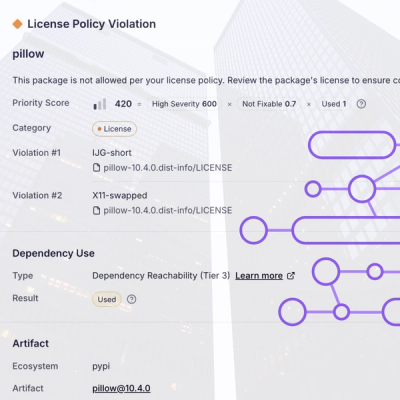
Research
/Security News
Critical Vulnerability in NestJS Devtools: Localhost RCE via Sandbox Escape
A flawed sandbox in @nestjs/devtools-integration lets attackers run code on your machine via CSRF, leading to full Remote Code Execution (RCE).

Turn any python function into a real-time audio and video stream over WebRTC or WebSockets.
pip install fastrtc
to use built-in pause detection (see ReplyOnPause), and text to speech (see Text To Speech), install the vad and tts extras:
pip install "fastrtc[vad, tts]"
.ui.launch() method to launch the webRTC-enabled built-in Gradio UI..mount(app) method to mount the stream on a FastAPI app and get a webRTC endpoint for your own frontend!.mount(app) method to mount the stream on a FastAPI app and get a websocket endpoint for your own frontend!fastphone() method of the stream to launch the application and get a free temporary phone number!Stream can easily be mounted on a FastAPI app so you can easily extend it to fit your production application. See the Talk To Claude demo for an example of how to serve a custom JS frontend.See the Cookbook for examples of how to use the library.
🗣️👀 Gemini Audio Video ChatStream BOTH your webcam video and audio feeds to Google Gemini. You can also upload images to augment your conversation! |
🗣️ Google Gemini Real Time Voice APITalk to Gemini in real time using Google's voice API. |
🗣️ OpenAI Real Time Voice APITalk to ChatGPT in real time using OpenAI's voice API. |
🤖 Hello ComputerSay computer before asking your question! |
🤖 Llama Code EditorCreate and edit HTML pages with just your voice! Powered by SambaNova systems. |
🗣️ Talk to ClaudeUse the Anthropic and Play.Ht APIs to have an audio conversation with Claude. |
🎵 Whisper TranscriptionHave whisper transcribe your speech in real time! |
📷 Yolov10 Object DetectionRun the Yolov10 model on a user webcam stream in real time! |
🗣️ Kyutai MoshiKyutai's moshi is a novel speech-to-speech model for modeling human conversations. |
🗣️ Hello Llama: Stop Word DetectionA code editor built with Llama 3.3 70b that is triggered by the phrase "Hello Llama". Build a Siri-like coding assistant in 100 lines of code! |
This is a shortened version of the official usage guide.
.ui.launch(): Launch a built-in UI for easily testing and sharing your stream. Built with Gradio..fastphone(): Get a free temporary phone number to call into your stream. Hugging Face token required..mount(app): Mount the stream on a FastAPI app. Perfect for integrating with your already existing production system.from fastrtc import Stream, ReplyOnPause
import numpy as np
def echo(audio: tuple[int, np.ndarray]):
# The function will be passed the audio until the user pauses
# Implement any iterator that yields audio
# See "LLM Voice Chat" for a more complete example
yield audio
stream = Stream(
handler=ReplyOnPause(echo),
modality="audio",
mode="send-receive",
)
from fastrtc import (
ReplyOnPause, AdditionalOutputs, Stream,
audio_to_bytes, aggregate_bytes_to_16bit
)
import gradio as gr
from groq import Groq
import anthropic
from elevenlabs import ElevenLabs
groq_client = Groq()
claude_client = anthropic.Anthropic()
tts_client = ElevenLabs()
# See "Talk to Claude" in Cookbook for an example of how to keep
# track of the chat history.
def response(
audio: tuple[int, np.ndarray],
):
prompt = groq_client.audio.transcriptions.create(
file=("audio-file.mp3", audio_to_bytes(audio)),
model="whisper-large-v3-turbo",
response_format="verbose_json",
).text
response = claude_client.messages.create(
model="claude-3-5-haiku-20241022",
max_tokens=512,
messages=[{"role": "user", "content": prompt}],
)
response_text = " ".join(
block.text
for block in response.content
if getattr(block, "type", None) == "text"
)
iterator = tts_client.text_to_speech.convert_as_stream(
text=response_text,
voice_id="JBFqnCBsd6RMkjVDRZzb",
model_id="eleven_multilingual_v2",
output_format="pcm_24000"
)
for chunk in aggregate_bytes_to_16bit(iterator):
audio_array = np.frombuffer(chunk, dtype=np.int16).reshape(1, -1)
yield (24000, audio_array)
stream = Stream(
modality="audio",
mode="send-receive",
handler=ReplyOnPause(response),
)
from fastrtc import Stream
import numpy as np
def flip_vertically(image):
return np.flip(image, axis=0)
stream = Stream(
handler=flip_vertically,
modality="video",
mode="send-receive",
)
from fastrtc import Stream
import gradio as gr
import cv2
from huggingface_hub import hf_hub_download
from .inference import YOLOv10
model_file = hf_hub_download(
repo_id="onnx-community/yolov10n", filename="onnx/model.onnx"
)
# git clone https://huggingface.co/spaces/fastrtc/object-detection
# for YOLOv10 implementation
model = YOLOv10(model_file)
def detection(image, conf_threshold=0.3):
image = cv2.resize(image, (model.input_width, model.input_height))
new_image = model.detect_objects(image, conf_threshold)
return cv2.resize(new_image, (500, 500))
stream = Stream(
handler=detection,
modality="video",
mode="send-receive",
additional_inputs=[
gr.Slider(minimum=0, maximum=1, step=0.01, value=0.3)
]
)
Run:
stream.ui.launch()
```py
stream.fastphone()
```
app = FastAPI()
stream.mount(app)
# Optional: Add routes
@app.get("/")
async def _():
return HTMLResponse(content=open("index.html").read())
# uvicorn app:app --host 0.0.0.0 --port 8000
FAQs
The realtime communication library for Python
We found that fastrtc demonstrated a healthy version release cadence and project activity because the last version was released less than a year ago. It has 1 open source maintainer collaborating on the project.
Did you know?

Socket for GitHub automatically highlights issues in each pull request and monitors the health of all your open source dependencies. Discover the contents of your packages and block harmful activity before you install or update your dependencies.

Research
/Security News
A flawed sandbox in @nestjs/devtools-integration lets attackers run code on your machine via CSRF, leading to full Remote Code Execution (RCE).

Product
Customize license detection with Socket’s new license overlays: gain control, reduce noise, and handle edge cases with precision.

Product
Socket now supports Rust and Cargo, offering package search for all users and experimental SBOM generation for enterprise projects.